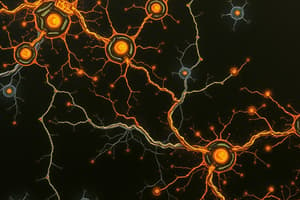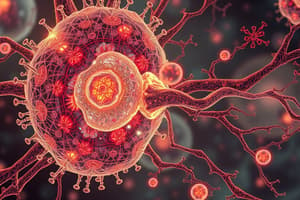Podcast
Questions and Answers
What occurs first in the process of Tyrosine Kinase Reception?
What occurs first in the process of Tyrosine Kinase Reception?
- ATP molecules dephosphorylate ligands
- Ligands bind to receptor Tyrosine Kinase proteins (correct)
- Cytoskeletal proteins are activated
- Relay proteins undergo dimerization
What role does cAMP play in the signaling pathway?
What role does cAMP play in the signaling pathway?
- It phosphorylates ATP directly
- It binds directly to the receptor Tyrosine Kinase
- It acts as a secondary messenger (correct)
- It inhibits the activation of protein kinase A
What is the final effect of the phosphorylation cascade in the signaling pathway?
What is the final effect of the phosphorylation cascade in the signaling pathway?
- Formation of ATP from ADP
- Inhibition of cytoskeleton changes
- Activation of cytoskeletal proteins (correct)
- Release of signaling molecules into the bloodstream
Which statement best describes amplification in signaling pathways?
Which statement best describes amplification in signaling pathways?
What might inhibit the signaling cascade in a cell?
What might inhibit the signaling cascade in a cell?
What is the primary purpose of meiosis in sexually reproducing organisms?
What is the primary purpose of meiosis in sexually reproducing organisms?
What occurs to a zygote after fertilization?
What occurs to a zygote after fertilization?
Which of the following best describes genetic recombination?
Which of the following best describes genetic recombination?
Where does fertilization typically take place in the female reproductive system?
Where does fertilization typically take place in the female reproductive system?
What is the characteristic of a haploid cell?
What is the characteristic of a haploid cell?
Why is communication between cells important in multicellular organisms?
Why is communication between cells important in multicellular organisms?
Which of the following is a method through which cells send messages?
Which of the following is a method through which cells send messages?
What type of substances do cells primarily use to convey messages?
What type of substances do cells primarily use to convey messages?
Do all cells receiving a message respond identically?
Do all cells receiving a message respond identically?
What role do hormones play in cellular communication?
What role do hormones play in cellular communication?
What happens to the number of chromosomes during interphase in meiosis 1?
What happens to the number of chromosomes during interphase in meiosis 1?
How many times does meiosis 1 occur during the meiotic process?
How many times does meiosis 1 occur during the meiotic process?
What is the final state of chromosomes in each cell after meiosis 1?
What is the final state of chromosomes in each cell after meiosis 1?
Which stage is NOT part of mitosis?
Which stage is NOT part of mitosis?
What is the significance of sister chromatids during meiosis 1?
What is the significance of sister chromatids during meiosis 1?
What is the first step in paracrine signaling?
What is the first step in paracrine signaling?
During synaptic signaling, what triggers the release of neurotransmitters?
During synaptic signaling, what triggers the release of neurotransmitters?
What role does the local regulator have in paracrine signaling?
What role does the local regulator have in paracrine signaling?
What is the primary distinction between paracrine signaling and synaptic signaling?
What is the primary distinction between paracrine signaling and synaptic signaling?
Which component is involved in the synaptic signaling process?
Which component is involved in the synaptic signaling process?
What is the primary function of the endocrine cell in long-distance signaling?
What is the primary function of the endocrine cell in long-distance signaling?
How does the hormone travel to the target cell in long-distance signaling?
How does the hormone travel to the target cell in long-distance signaling?
What ensures that the target cell specifically responds to the hormone?
What ensures that the target cell specifically responds to the hormone?
Which of the following best describes what happens after the hormone binds to the receptor on the target cell?
Which of the following best describes what happens after the hormone binds to the receptor on the target cell?
What role do blood vessels play in the process of long-distance signaling?
What role do blood vessels play in the process of long-distance signaling?
What is the purpose of the receptor in the signal transduction pathway?
What is the purpose of the receptor in the signal transduction pathway?
Which part of the cell does transduction occur after the receptor is activated?
Which part of the cell does transduction occur after the receptor is activated?
What initiates the cascade of events in the transduction process?
What initiates the cascade of events in the transduction process?
What is the final action taken by the cell after the signal is transduced?
What is the final action taken by the cell after the signal is transduced?
Which of the following best describes the role of relay molecules in transduction?
Which of the following best describes the role of relay molecules in transduction?
What type of signaling utilizes hormones as signaling molecules?
What type of signaling utilizes hormones as signaling molecules?
Which characteristic is associated with paracrine signaling?
Which characteristic is associated with paracrine signaling?
Which of the following accurately describes endocrine signaling?
Which of the following accurately describes endocrine signaling?
What distinguishes local regulators in signaling processes?
What distinguishes local regulators in signaling processes?
Which statement is true about both endocrine and paracrine signaling?
Which statement is true about both endocrine and paracrine signaling?
What occurs during the first step of the G protein-coupled receptor mechanism?
What occurs during the first step of the G protein-coupled receptor mechanism?
What happens to the G protein when it is activated?
What happens to the G protein when it is activated?
Which option accurately describes the termination step in the GPCR mechanism?
Which option accurately describes the termination step in the GPCR mechanism?
What is the role of the activated enzyme in the GPCR mechanism?
What is the role of the activated enzyme in the GPCR mechanism?
What occurs during the signal transduction step of the GPCR pathway?
What occurs during the signal transduction step of the GPCR pathway?
What is the first step in the cell signaling pathway activated by a growth factor?
What is the first step in the cell signaling pathway activated by a growth factor?
What does the phosphorylation cascade primarily involve?
What does the phosphorylation cascade primarily involve?
What is the ultimate effect of the cell signaling pathway activation?
What is the ultimate effect of the cell signaling pathway activation?
Which component of the cell signaling pathway is responsible for regulating gene expression?
Which component of the cell signaling pathway is responsible for regulating gene expression?
In cell signaling, what is the role of mRNA?
In cell signaling, what is the role of mRNA?
Where does the activated transcription factor move to after its activation?
Where does the activated transcription factor move to after its activation?
What is a key characteristic of a growth factor in cell signaling?
What is a key characteristic of a growth factor in cell signaling?
What initiates the signaling cascade in a cell signaling pathway?
What initiates the signaling cascade in a cell signaling pathway?
Flashcards
Meiosis
Meiosis
Cell division that reduces chromosome number from diploid (2n) to haploid (n) in sexually reproducing organisms.
Genetic recombination
Genetic recombination
The shuffling of genetic material during meiosis, resulting in offspring with new combinations of traits.
Fertilization
Fertilization
The fusion of sperm and egg to form a zygote.
Haploid cell
Haploid cell
Signup and view all the flashcards
Diploid cell
Diploid cell
Signup and view all the flashcards
What happens during Meiosis 1's S-phase?
What happens during Meiosis 1's S-phase?
Signup and view all the flashcards
What's special about the chromosome number in interphase of Meiosis 1?
What's special about the chromosome number in interphase of Meiosis 1?
Signup and view all the flashcards
Haploid chromosome
Haploid chromosome
Signup and view all the flashcards
Meiosis 1 happens how many times?
Meiosis 1 happens how many times?
Signup and view all the flashcards
Why do sister chromatids separate in Meiosis 1?
Why do sister chromatids separate in Meiosis 1?
Signup and view all the flashcards
Paracrine Signaling
Paracrine Signaling
Signup and view all the flashcards
Tyrosine Kinase Reception
Tyrosine Kinase Reception
Signup and view all the flashcards
cAMP Transduction
cAMP Transduction
Signup and view all the flashcards
Phosphorylation Cascade
Phosphorylation Cascade
Signup and view all the flashcards
Cytoskeleton Changes
Cytoskeleton Changes
Signup and view all the flashcards
Cell Communication in Multicellular Organisms
Cell Communication in Multicellular Organisms
Signup and view all the flashcards
Why is cell communication important?
Why is cell communication important?
Signup and view all the flashcards
How do cells send messages?
How do cells send messages?
Signup and view all the flashcards
Types of cell messages
Types of cell messages
Signup and view all the flashcards
Different cells, different responses
Different cells, different responses
Signup and view all the flashcards
Synaptic Signaling
Synaptic Signaling
Signup and view all the flashcards
Local Regulator
Local Regulator
Signup and view all the flashcards
Neurotransmitter
Neurotransmitter
Signup and view all the flashcards
What is the difference between paracrine and synaptic signaling?
What is the difference between paracrine and synaptic signaling?
Signup and view all the flashcards
Long-distance signaling
Long-distance signaling
Signup and view all the flashcards
Endocrine signaling
Endocrine signaling
Signup and view all the flashcards
Endocrine signaling
Endocrine signaling
Signup and view all the flashcards
Hormone
Hormone
Signup and view all the flashcards
Hormones
Hormones
Signup and view all the flashcards
Target cell
Target cell
Signup and view all the flashcards
Blood
Blood
Signup and view all the flashcards
What happens when a hormone binds to a target cell?
What happens when a hormone binds to a target cell?
Signup and view all the flashcards
Signal Transduction Pathway
Signal Transduction Pathway
Signup and view all the flashcards
Reception
Reception
Signup and view all the flashcards
Transduction
Transduction
Signup and view all the flashcards
Response
Response
Signup and view all the flashcards
Relay Molecules
Relay Molecules
Signup and view all the flashcards
GPCR Mechanism
GPCR Mechanism
Signup and view all the flashcards
Signal Reception
Signal Reception
Signup and view all the flashcards
Signal Transduction
Signal Transduction
Signup and view all the flashcards
Cellular Response Initiation
Cellular Response Initiation
Signup and view all the flashcards
Termination
Termination
Signup and view all the flashcards
Growth Factor
Growth Factor
Signup and view all the flashcards
Growth Factor Receptor
Growth Factor Receptor
Signup and view all the flashcards
Transcription Factor
Transcription Factor
Signup and view all the flashcards
What is the role of DNA in cell signaling?
What is the role of DNA in cell signaling?
Signup and view all the flashcards
How does mRNA play a role in a cell signaling pathway?
How does mRNA play a role in a cell signaling pathway?
Signup and view all the flashcards
What is the overall outcome of a cell signaling pathway?
What is the overall outcome of a cell signaling pathway?
Signup and view all the flashcards




